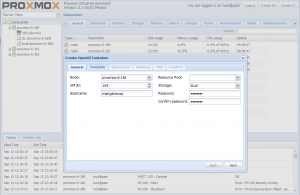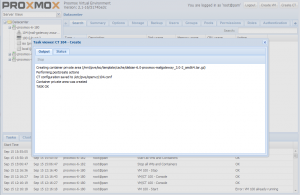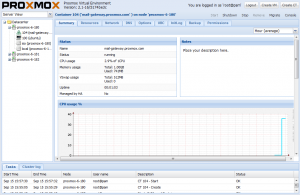Difference between revisions of "Installation"
| Line 86: | Line 86: | ||
[[Image:Screen-create-container-mailgateway-log.png|thumb|Create Virtual Machine - log]] | [[Image:Screen-create-container-mailgateway-log.png|thumb|Create Virtual Machine - log]] | ||
[[Image:Screen-virtual-machine-detail1.png|thumb|Running Virtual Machine]] | [[Image:Screen-virtual-machine-detail1.png|thumb|Running Virtual Machine]] | ||
| + | |||
Go to "VM Manager/Virtual Machines - Create": | Go to "VM Manager/Virtual Machines - Create": | ||
| Line 108: | Line 109: | ||
Now review your settings and create your first Virtual Machine. After you clicked "Create", all settings are applied - wait for completion (this process can take between a view seconds and up to a minute, depends on the used template and your hardware). Now, go to "VM Manager/Virtual Machines - List" to see the newly created Virtual Machine. | Now review your settings and create your first Virtual Machine. After you clicked "Create", all settings are applied - wait for completion (this process can take between a view seconds and up to a minute, depends on the used template and your hardware). Now, go to "VM Manager/Virtual Machines - List" to see the newly created Virtual Machine. | ||
| + | |||
| + | ===Video Tutorials=== | ||
| + | *[[Proxmox Mail Gateway on Proxmox VE (Video)]] | ||
==Fully virtualized Machines (KVM)== | ==Fully virtualized Machines (KVM)== | ||
Revision as of 12:28, 13 November 2008
Introduction
Proxmox VE installs the complete operating system and management tools in 3 to 5 minutes (depends on the used hardware).
Including the following:
- Complete operating system (Debian Etch 64)
- Partition the hard drive with LVM2
- Proxmox VE Kernel with OpenVZ and KVM support
- Backup/Restore tools
- Web based management interface
Please note, the complete server is used and all existing data is removed.
Video tutorials
List of all tutorials: Video Tutorials
Proxmox VE installation
Screen cast video demo of container installation
Note: These external videos are based on a beta version of Proxmox VE
System requirements
For production servers, high quality server equipment is needed. Keep in mind, if you run 10 Virtual Servers on one machine and you got a hardware failure, 10 services are lost. Proxmox VE supports clustering, means that multiple Proxmox VE installations can centrally managed via the included cluster functionality.
Proxmox VE uses local storage (DAS), there is no need for expensive SAN equipment.
Minimum requirements for evaluation:
- CPU: 64bit (Intel EMT64 or AMD64), Intel VT/AMD-V capable CPU/Mainboard (for KVM Full Virtualization support)
- Minimum 1 GB RAM
- Hard drive
- One NIC
Recommended system requirements:
- CPU: 64bit (Intel EMT64 or AMD64), Multi core CPU recommended, Intel VT/AMD-V capable CPU/Mainboard (for KVM Full Virtualization support)
- 4 GB is good, more is better
- Hardware RAID with batteries backup
- Fast hard drives, best results with 15krpm SAS, Raid10
- Two NIC
Certified hardware
Basically you can use all hardware supporting Debian Etch 64 bit. If you are unsure, just pick one of these:
- HP DL380G5
- IBM x3650
Steps to get your Proxmox VE up and running
Install Proxmox VE server
- Download ISO image and burn it on a CD (see Downloads)
- Boot from CD and start the automatic installer on your dedicated hardware
- Follow the instructions on the screen
Proxmox VE installation (Video)
Proxmox VE web interface
Configuration is done via web interface, just point your browser to the given IP address during installation (https://youripaddress). Please make sure that your browser has sun-java plugin installed (GCJ for firefox does not work yet) as this is used for console view. Proxmox VE is tested for IE6/IE7, firefox 2.x and 3.x
Default login is "root" with the password "admin" on beta installations - this is also the root account for console access. Please change the password. If you install 1.0 or later, the root password is set during the installation process.
Configure basic system setting
Please review the following settings, see "Configuration/System":
- Network
- DNS
- Time settings
- Options: language (for the management web interface)
- Options: set the keyboard layout (needed by VNC clients)
Get Appliance Templates
Download
Just go to "VM Manager/Appliance Templates" and download pre-built Virtual Appliances directly to your server. This list is maintained by the Proxmox team and more and more Appliances will be available. This is the easiest way and a good place to start.
Upload from your desktop
If you already got Virtually Appliances you can upload them via the upload button. To install a virtual machine from an ISO image (using KVM full virtualization) just upload the ISO file via the upload button (limited to 2 GB).
Directly to filesystem
Templates and ISO images are stored on the Proxmox VE server (see /var/lib/vz/template/cache for openvz templates and /var/lib/vz/template/iso for ISO images). You can also transfer templates and ISO images via secure copy (scp) to these directories. If you work on a windows desktop, you can use a graphical scp client like winscp.
Create Virtual Machines
Container (OpenVZ) Virtual Machines - Default
Go to "VM Manager/Virtual Machines - Create":
Configuration:
- Type: select "Container (OpenVZ)"
- Template: select "proxmox-mailgateway" (or whatever you want)
- Hostname: give a unique server name
- Memory (MB): default 512 MB
- Swap (MB): default 512 MB
- Password: set the root password
- VMID: just use the given ID or overwrite the suggested one
- Cluster Node: If you have several Proxmox VE servers, select the node where you want to create the new virtual machine
- Start at boot: tick this if you want the Virtual Machine started on reboot of the Proxmox VE server
- Disk space (GB): default value 8 GB - please note you can change this later without reboot or modifications within the Virtual Appliance (very cool).
Network:
- Network Type: default Virtual Network (venet) - in only some case you need Bridged Ethernet(veth) here (see OpenVZ wiki for details
- IP Address: give a unique IP (if you select Brigded Ethernet, the IP configuration has to be done in the Virtual Machine)
- DNS Domain: e.g. yourdomain.com
- First/Second DNS Servers: enter DNS servers
Now review your settings and create your first Virtual Machine. After you clicked "Create", all settings are applied - wait for completion (this process can take between a view seconds and up to a minute, depends on the used template and your hardware). Now, go to "VM Manager/Virtual Machines - List" to see the newly created Virtual Machine.
Video Tutorials
Fully virtualized Machines (KVM)
Go to "VM Manager/Virtual Machines - Create":
Configuration:
- Type: select "Fully virtualized (KVM)"
- Installation Media: select "cdrom device" (from the Proxmox VE server, or a previously uploaded ISO image)
- Name: give a unique name
- Disk space (GB): specify the size of the disk - will not preallocated - give enough as changing later is not possible without command line interactions and guest specific issues
- Memory (MB): specify memory as you would give on physical hardware (SWAP is handled within the guest)
- VMID: just use the given ID or overwrite the suggested one
- Cluster Node: If you have several Proxmox VE servers, select the node where you want to create the new virtual machine
- Start at boot: tick this if you want the Virtual Machine started on reboot of the Proxmox VE server
- Disk type: select IDE for windows guests, (optional SCSI or VIRTIO for Linux guests)
- Guest Type: select what you need (32 and 64 bit guests are possible)
Network:
- Network Type: Bridged Ethernet(tap)
- Bridge: select one (default only one is configured)
- Network Card: select the emulated hardware - rtl8139 is default (if you have VIRTIO drivers in your guest, use VIRTIO)
Now review your settings and create your first Virtual Machine. After you clicked "Create", all settings are applied - wait for completion. Now, go to "VM Manager/Virtual Machines - List" to see the newly created Virtual Machine.
Managing Virtual Machines
Go to "VM Manager/Virtual Machines" to see a list of your Virtual Machines.
Basic tasks can be done by clicking on the red arrow - drop down menu:
- start, restart, shutdown, stop
- migrate: migrate a Virtual Machine to another physical host (you need at least two Proxmox VE servers - see Proxmox VE Cluster
- console: using the VNC console for container virtualization automatically logs in via root. For managing KVM Virtual Machine, the console shows the screen of the full virtualized machine)
For a detailed view and configuration changes just click on a Virtual Machine.
"Logs" on a container Virtual Machine:
- Boot/Init: shows the Boot/Init logs generated during start or stop
- Command: see the current/last executed task
- Syslog: see the real time syslog of the Virtual Machine
Networking and Firewall
A detail guide on how to virtualize your VPS network infrastructure. [3]


